VamoScience, Plus High-Techmobility.
Hydrogen: Burn or Cell?
(8/24/22)—Fossil fuels beget hybrid/electric? Then again, why not just throw a baby Jackery into the bathwater, see what flies? Well not quite, but cleanly turning electrolyzed water into hydrogen aeronautical propulsion is an alternative process that has clearly been energizing airlines such as Alaska, United and British Air (to the tune of 1k preorders). Now American Airlines is potentially ordering some 100 more hydro-electric engines for its shorter run regional planes, so as to reduce the carrier’s carbon footprint.
Which only raises a broader question of which hydrogenous route to take. That is, UAL would be placing its investment bet on ZeroAvia’s fuel cell approach, the British-American start-up’s technology converts hydrogen into electricity to power an aircraft’s engines. Conversely, so-called purer ‘hydrogen planes’ 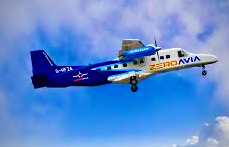 burn the gas form in more standard turbine engines, storing it in onboard tanks like current jet fuels.
burn the gas form in more standard turbine engines, storing it in onboard tanks like current jet fuels.
Both hydrogen power lanes have their speed bumps however. Fuel cell systems (with supplemental batteries) are heavy and underpowered range-wise for existing regional planes at this developmental stage. While liquid gas combustion requires greater storage space than conventional kerosene fuel and apparently can’t be stored in wing tanks, sparking critical airframe design issues. Moreover, comparatively less-efficient hydrogen gas powered engines emit large gobs of non-carbon water vapor and nitrous oxides—the green/environmental impact of which remains uncertain, regional aircraft generating but 7% of per-passenger carbon emissions.
So which powerplant, for which planes? Major interested regionals are looking for 50-seat turboprops ranging at least 400 miles—minimally needing 2k to 5k kilowatts of hydrogen-electric fuel cell power. But ZeroAvia’s powertrain program is currently limited to 600-kilowatt output in a 19-seat Dornier 228 scheduled for certification in 2024 (along with a companion 228 with conventional engines). The ZA engines may not be stoked enough to adequately power regional craft until 2026, nor larger A320-type jetliners until the 2030s. All reason enough why Airbus presently plans to test both hydrogen-fuel technologies, even as industry observers lean toward liquid gas as the more burning option.
In any case, the International Council on Clean Transportation foresees ‘hydro jets’ comprising some 50% of regional and single-aisle aircraft sales by the post-fossil fueled 2050s. Between now and then, Vamigré will continue sussing out hydrogen fuel’s electrifying hot-water power and progress from the mere hyping fumes and plumes of hot air. (MTC…)![]()
Flying Taxis: Up or Down?
(8/13/22)—United Airlines is apparently wagering on the upside, hailing the future of vertical takeoff and landing (eVTOL) aircraft with $10m in ‘predelivery’ payments for 100 of these electric flying machines—following through on United Airlines Holdings Inc.’s 2021 purchase agreement for 200 units. In UAL’s prop wash, Delta is floating $60m into electric flying air taxi rival, Joby Aviation (partially backed by Uber Technologies) with a further $200m investment based upon Joby’s production/delivery milestones.
(Update: 7/27/23+)—Joby, with the added help of a Toyota partnership and a $180m investment by Baillie Gifford, has since unveiled its first full eVTOL production prototype, upon gaining a special airworthiness certificate from the FAA, which allows the Marina, CA company to begin flight testing. Next step: FAA type and certification of Joby’s eVTOL aircraft design and component parts—en route to commercial viability and an aerial rideshare service target of late 2024 into 2025.
Also driving this ‘helicab’ promise is Archer Aviation Inc, a San Jose, CA-based company, one of several to be rapidly developing such ‘flying taxi’ technologies, none of which have yet been fully certified by US or fellow international regulators. Nevertheless, UAL’s vote of confidence is the first cash customer bet on this fledgling craft, as the carrier seeks to be a first-to-market leader in speedy, innovative, environmentally sustainable transportation—mainly from most anywhere in congested cities to/from its hub airports. A lofty goal these smoggy, smokey, traffic-jammed days, that cannot be denied.
The buzzword here is eVTOL, helicopter-like planes lifting to some 50 feet, then transitioning forward, winging up and along at 150 mph with range of some 60 miles before gently landing at a given 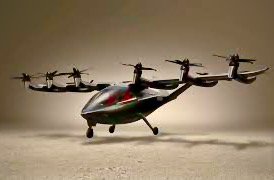 destination pad. Archer’s demonstration model is called ‘Maker’, battery powered with 12 propeller motors mounted fore and aft wing. Quiet, zero emissions, lightweight composite structure, the whole enviro shmeer: Maker is designed to carry two passengers in comfortable ergonomic seats, with ample leg room, not to mention 270-degree wraparound window views—so up, up and awayyy, right?
destination pad. Archer’s demonstration model is called ‘Maker’, battery powered with 12 propeller motors mounted fore and aft wing. Quiet, zero emissions, lightweight composite structure, the whole enviro shmeer: Maker is designed to carry two passengers in comfortable ergonomic seats, with ample leg room, not to mention 270-degree wraparound window views—so up, up and awayyy, right?
Thing is, Archer isn’t the only air cab outfit honking, jostling for pole position. American Airlines Group invested $25m in Vertical Aerospace Ltd., a different electro-aircraft startup, also signing up for predelivery payments on 50 eVTOLS, although no palms have been greased thus far. Then there is Archer’s legal dust-up with rival Wisk Aero LLC of Mountain View, CA. It plans to introduce the sixth generation of a yellow ‘Cora’ (now four passenger) autonomous air taxi in fall, 2023, via FAA certification after 1,600 successful test flights. In the air as well are City Airbus Next Gen and City Hawks by Israel’s Urban Aeronautics–an air taxi traffic jam in the making?
Meantime, (Boeing-backed) Wisk has sued Archer over an alleged hack job of design and trade secrets, as well as patent infringement, allegedly perpetrated by former Archer engineers. The latter party counterclaims that 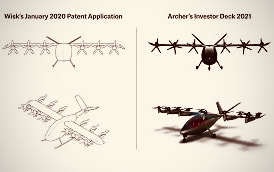 Wisk is lobbing false statement spitballs to smear its reputation and business—a complicated case that may drag on both companies’ updraft for months to come.
Wisk is lobbing false statement spitballs to smear its reputation and business—a complicated case that may drag on both companies’ updraft for months to come.
That downside aside, Archer anticipates FAA certification by late 2024, Wisk not far behind on its route to production of 2,000 such Cora-type planes within five years. Among issues still to be aired out all around, however, will involve viable onboard battery pack size/capacity, and carving out spacious ground helipads/stations/ areas, given the wide disk area required for rotor blades during takeoff and landing.
In any event, the eVTOL goal is safe urban air mobility, commuting or exploring across an (on-demand) aerial ridesharing network—i.e., flying efficiently upright without getting flagged down.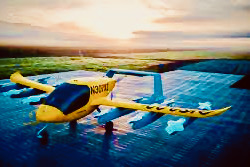
Quite the cab-forward venture to be sure, with United already mapping out where and when its Archer flying taxis will be eVTOLing—as yet other electric aero startups enter the air race from all directions. For their part, aviation regulators and passengers worldwide will likely still wonder where they can catch a decent cab when they need one.
These ups and downs or no, the aero taxi meter is definitely running now, and Vamigré will see to it that all the competing cab lines are playing fast but fare once we begin hailing them on rainy Friday afternoons. For we won’t take a back seat from just anyone. (MTC…)
Riding the Float and Glide.
9/22/22—Island hopping on a cushy pillow of balmy air: That’s what a Hawaiian company is banking on as the future of the state’s inter-island passage.
They’re called sea gliders, electric boat-plane hybrids in development by Boston startup, Regent that are designed to cruise smoothly some 10 to 30 feet above ocean waves, on relatively short runs between the Sandwich Isles (a 1/4 scale prototype is currently in trials). Battery-powered, the ‘air-boats’ are projected to reach a range of 180 miles at speeds of up to 180 m.p.h., carrying more passengers (upwards of 100?) more efficiently than any other electric propulsion aircraft currently in the R&D phase—largely seaplane models carrying 8-10 passengers.
How so? Hawaiian Holdings Inc. explains that these gliders would operate via a “wing-in-ground effect”—flying on an air cushion measuring a maximum length of the glider’s wingspan above the water, thereby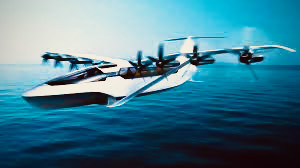 creating “wave tolerance” to smooth out the ride. That is, after hydroplaning up out of their idling harbor float at 20 to 50 m.p.h., the gliders will lift off into open waters, digital flight control technology monitoring gusts and rough waves to keep the greener, cleaner ‘ground-effect vehicles’ fly/sailing sure and steady, harbor to harbor, from there.
creating “wave tolerance” to smooth out the ride. That is, after hydroplaning up out of their idling harbor float at 20 to 50 m.p.h., the gliders will lift off into open waters, digital flight control technology monitoring gusts and rough waves to keep the greener, cleaner ‘ground-effect vehicles’ fly/sailing sure and steady, harbor to harbor, from there.
Clearly the islands would welcome such an added ‘flying carpet’-style transport mode, not to mention HH’s Hawaiian Airlines: since the short-but-ever busy inter-island channel routes accounted for 20% of the carrier’s revenue and over half of its seats sold in 2019. Plenty big business in and around paradise, sweetened and stirred with the Aloha spirit.
Now whether splashy sea gliders and the like would be an appealing, advantageous service to us Hawaii-bound travelers—much less those venturing to similar island destinations worldwide—is another fish kettle entirely.
Regent envisions its gliders taking off commercially by 2028, so they’d better hop to it now. Meantime, Vamigré will see what flies safely and when—open mindset being: whatever floats our boats. (MTC…)
Too Hot to Trot?
PSST, no BS, the world is getting smaller, the planet getting warmer by the day.
Undeniable climate change, whether man-made or cyclical, is creating thicker, more hazardous levels of smog, acid rainfall and greenhouse gasfires the globe over—thus VamoSpheric weather news and takes.
Sweltering, triple-digit days are increasing worldwide, becoming the scorching norm—the nearer the Equator, the less bearable. Yet even northern climes are drier and hotter. So widespread wildfires now plaguing Southern Europe and Africa also hit the U.S. Pacific Northwest, grilling Oregon; British Columbia blazes turning the Seattle area into a choking smokehouse of Peking proportions, affecting travelers and indigenous wildlife alike.
At the same time, icepack melts alarmingly, pole to pole (including Greenland), resulting in rapid sea-level rise in coastal areas globally and chronic flooding (e.g., the havoc, destruction caused by Hurricanes Irma, Harvey and Maria; the deadly Mexico earthquakes) in ensuing years. Again, animal life now suffers like coal mine canaries—polar bears to to sperm whales and sea lions. This, while algae and plastics create oceanic ‘dead zones’ and neurotoxic islands of trash, vivid coral reefs bleach out en masse.
Yet the current U.S. administration is rife with climate change deniers (whose home districts inevitably seem harder hit by natural disasters), and has already pulled out of the Paris Accords, vowing to essentially gut the EPA—all so against the global grain. Thus Vamigré will follow and chart environmental decline and mutations, specifically as they affect traveler freedom of movement by destination and region, eschewing mega-theme parks and smoky tourist buses for smaller footprints and tire tracks—as well as overly dour, demanding ‘greeneology’. 
Also monitored will be the cumulative carbon skyprint (polluting contrails) and planet warming gases generated by airliner and smaller aircraft emissions.
As new, uncharted climate and meteorological patterns emerge, how will the more frequently red-zone overheated summer VamoStorms, tornadoes/hurricane/cyclones , surges and other powerful disturbances disrupt schedules, delay flights, force lengthy, spreading cancellations altogether. Much less the Glycol spraying of jet ice amid brutal, blinding winter blizzards and freezing storms.
For such extreme, crippling conditions (note: Hurricanes Harvey, Irma, Jose and rising waters) will only increase in days and seasons to come…. + CLIMATITIS: Seeing Red, Sea to Sea
Tech: VamoSystems/Circuits/Sockets:📌
Beyond the Trumpian/TSA laptop, tablet and other electronics flap, we will keep diligent eye on technological developments as they affect, aid and abet traveler Vamomentum. 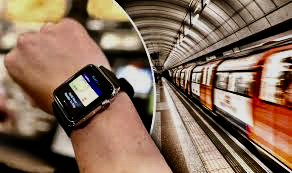
For instance, what will be allowed aboard cabins inflight, from WiFi to cell phoning (even during take-offs and landings)—as well as the row by row, seat by seat etiquette as to viewing and calling?
With regard to smartphones, Vamigré will regularly preview, rate and review apps designed to better facilitate itinerary management, bookings/check-in, boarding, seat, legroom and food/snacks; mapping out road road trips, and tracking luggage—yikes, even itinerary management and spreadsheet software.
Mac and Freeze: FAA Rules Certain MacBook Pros a No-Go.
Speaking of laptops, with Apple having announced a voluntary recall and replacement ![]() program last June, it is curious that has taken over a month and a half to ban some of them from carry-on luggage or cargo holds.
program last June, it is curious that has taken over a month and a half to ban some of them from carry-on luggage or cargo holds.
The short of it is that a series of mid-2015 15-inch MBP’s, sold between September ’15 and February 2017 ( over 430,000 in the U.S. alone), have batteries subject to overheating and quite possibly catching fire.
Following the lead of EU’s Aviation Safety Agency, the FAA has just decreed that such Apple laptops having not yet received battery replacements won’t be allowed (much less operated) on U.S. flights. So until all these faulty batteries have been replaced, it looks like the MacBook freeze is on.
On a larger scale, how are global computer systems bolstering airline schedules/services, or software failures causing same to break down, leaving travelers stalled and stranded in harrowing, interminable lines? Or having personal information at peril as carriers like Delta, British Airways and Cathay Pacific reveal computer system data breaches, affecting millions of passengers, long after the fact?
What’s up with airlines and airports increasing their video surveillance in the name of security, yet endeavoring to clamp down on travelers using their smartphones to photograph and video record in their own self-interest and protection—say, to document affronts and altercations?
Security In Your Face.
![]() Best be checking your grill and hairdo, because it looks like facial recognition is coming to an airport near you.
Best be checking your grill and hairdo, because it looks like facial recognition is coming to an airport near you.
That is, your mug will become your ID and boarding pass sooner than later, however cringeworthy that may appear, at least on the face of it.
Just step up and smile pretty for the camera: That’s already the routine at checkpoints and boarding gates for international flights at major airports across Europe, Asia—and is well on its way across the U.S.A.. Your photo will then be sent to Customs and Border Protection, 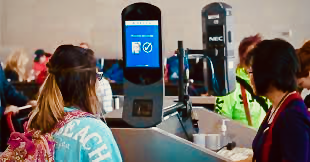 matched against their traveler and passport gallery to verify you are in fact whom you claim to be.
matched against their traveler and passport gallery to verify you are in fact whom you claim to be.
Proponents ‘assure’ that travelers’ mug shots will not be run/scanned against FBI or watchlist databases, and that the photos will be saved less than 24 hours. The CBP says it will only reference travelers’ images, not from other sources. Sure, reliability: This, while the U.S. CBP’s entire computer system just broke down—stifling, stranding international travelers with customs logjams coast to coast.
Delta Airlines is leading ‘FaceRec’ America for international travelers in its Atlanta Hartsfield base, claiming FR shaves at least 10% off boarding times—that 72% of its polled passengers like it so far. Other major airports around the country have been rapidly installing FR systems. The airline industry more broadly notes a 97% true match rate, and is pushing facial recognition to ease terminal overcrowding in the face of accelerating travel growth.
Travelers can choose to opt out of FaceRec, however, simply by producing our passports to TSA and gate agents as we always have. But chances are we’ll be relegated to the slower inspection lanes.
Nevertheless, FaceRec does pose privacy concerns over further hi-tech intrusion and  potential misuse/abuse. Is this just more governmental and/or corporate surveillance—tracking us everywhere we’re going, have been, when and with whom? What about biases against skin color and facial hair, 97% match rate notwithstanding?
potential misuse/abuse. Is this just more governmental and/or corporate surveillance—tracking us everywhere we’re going, have been, when and with whom? What about biases against skin color and facial hair, 97% match rate notwithstanding?
These issues already have some U.S. cities considering FaceRec bans. And Vamigré will be scanning the deployment of this latest air security technology—looking for any and all untoward digital wrinkles, warts, blemishes, lesions and other sore spots in the image processing. (MTC…)
Taking Wider Aim.
Meanwhile, how can we encourage/reward travelers to take fewer selfies, let alone the pro-staged variety—instead, shooting more and better ‘Elsies’ of that and those around them?
From there, we will explore the A/V gear and programs that augment Vameos and audio Vamoirs—personal to highly professional. Further on, our focus will be on the nascent development and refinement of augmented/enhanced reality technologies (e.g., ARKit, etc.) that apply to and enable Virtual Vamigré productions.
At the same time, close attention will be paid to the R&D of NASA’s X-Planes HWB, plus launches by Bezo’s Blue Origin, Musk’s Space Exploration/Space-X, and Virgin Galactic to begin space travel by paying passengers with the means to fork over seven figures.
Space Rangers or Astronots?
+See: VamoSpace: Craft or Cap?
![]() Sir Richard Branson recently upped the ante in this ‘space tourism’ race by boosting his Virgin Galactic program into the stratosphere of publicly traded companies. It appears the Social Capital Hedosophia Corporation—a so-called special-purpose acquisition company (SPAC) is prepared to invest some $800m in VG for a 49% of the venture. Branson claims that this injection should be ample to fuel the business toward commercial profitability. VG has already raised over $1b, primarily through the indefatigable tycoon himself.
Sir Richard Branson recently upped the ante in this ‘space tourism’ race by boosting his Virgin Galactic program into the stratosphere of publicly traded companies. It appears the Social Capital Hedosophia Corporation—a so-called special-purpose acquisition company (SPAC) is prepared to invest some $800m in VG for a 49% of the venture. Branson claims that this injection should be ample to fuel the business toward commercial profitability. VG has already raised over $1b, primarily through the indefatigable tycoon himself.
But skeptics question whether VG’ SpaceShipTwo can sustain itself on passenger revenue, when competitors such as Elon Musk’s SpaceX and Jeff Bezos’s Blue Origin are aiming more 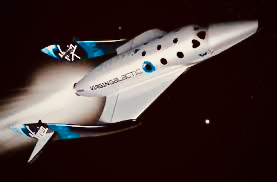 toward lucrative satellite launches as their commercial revenue source, with space tourism as a sidelight. Even NASA plans to offer monthlong stay overs on the international space station for $35k per day—all of these undercutting SSTwo’s projected fare (which may be VG’s funny money losing proposition from the very count down).
toward lucrative satellite launches as their commercial revenue source, with space tourism as a sidelight. Even NASA plans to offer monthlong stay overs on the international space station for $35k per day—all of these undercutting SSTwo’s projected fare (which may be VG’s funny money losing proposition from the very count down).
Now whether private citizens choose to pony up for a rocket ride remains to be seen, no matter how super rich and venturesome they may prove to be. Then again, Sir Richard has made a career of proving naysayers wrong, so Vamigré will be keeping an eye to the orbital skies, space-wise to high heavens. (MTC…)
So buckle up, Vamigrés…tray tables and floating fruit compotes in place…
